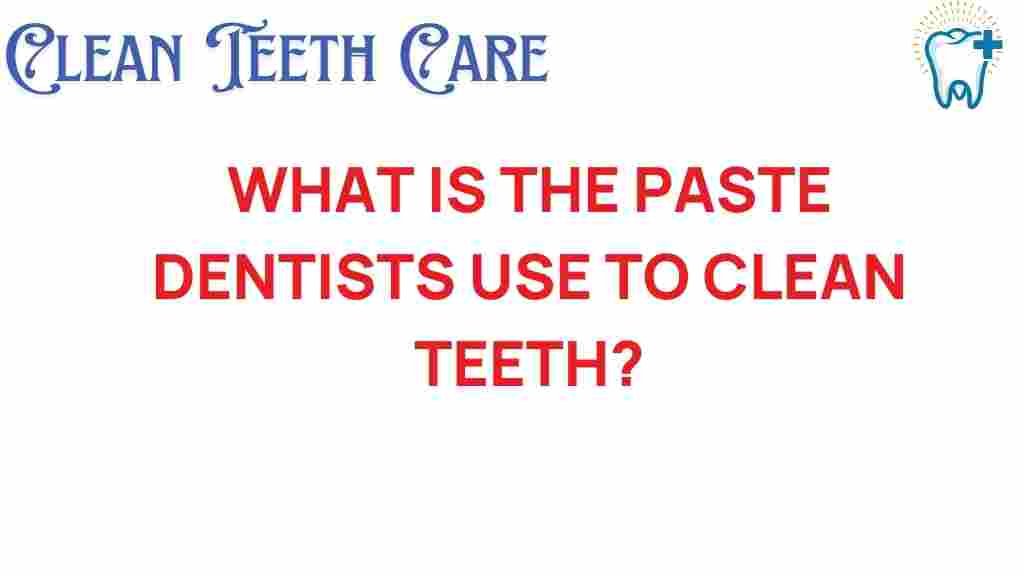Unveiling the Mystery: What Is the Paste Dentists Use to Clean Teeth?
Maintaining strong and healthy teeth is crucial for overall well-being, and regular visits to the dentist play a significant role in achieving optimal dental health. One key aspect of these visits is the use of specialized dental paste during professional cleaning sessions. In this article, we will explore what this paste is, its components, and how it contributes to effective teeth cleaning and overall oral hygiene.
What Is Dental Paste?
Dental paste is a specially formulated cleaning agent used by dentists to remove plaque, tartar, and stains from teeth surfaces during professional cleaning procedures. Unlike regular toothpaste, dental paste has a unique composition designed to enhance the cleaning process effectively.
Components of Dental Paste
Dental pastes typically contain various ingredients that serve different purposes in the cleaning process. Here are some of the primary components:
- Fluoride: A natural mineral that strengthens tooth enamel and helps prevent cavities.
- Abrasives: Fine particles like silica or calcium carbonate that scrub away plaque and stains.
- Humectants: Ingredients like glycerin that keep the paste moist and prevent it from drying out.
- Flavoring agents: To improve palatability, making the cleaning experience more enjoyable.
- Binding agents: To give the paste a consistent texture and help it adhere to toothbrushes and teeth.
How Dental Paste Is Used in Teeth Cleaning
During a dental visit, the dental paste is applied using specialized dentist tools that facilitate effective cleaning. Here’s a step-by-step process of how dental paste is used:
Step 1: Examination
The dentist begins with a thorough examination of your teeth and gums to identify any issues like plaque build-up or gum disease.
Step 2: Preparation
Once the examination is complete, the dentist prepares the necessary tools, including the dental paste, handpieces, and suction devices.
Step 3: Application of Dental Paste
The dental paste is applied to a rotating brush or cup, which is then used to scrub your teeth gently. The abrasive particles in the paste work to remove plaque and stains effectively.
Step 4: Rinsing
After scrubbing, the dentist will have you rinse your mouth to eliminate any residue from the dental paste and loosened debris.
Step 5: Fluoride Treatment
In many cases, a fluoride treatment is applied post-cleaning to provide additional protection against cavities and strengthen tooth enamel.
Benefits of Using Dental Paste for Teeth Cleaning
The use of dental paste in professional cleaning offers several advantages:
- Effective Plaque Removal: Dental paste is formulated to target and remove plaque build-up effectively.
- Stain Reduction: The abrasives in the paste help to diminish stains caused by food, beverages, or tobacco.
- Enamel Protection: Fluoride content helps to remineralize and protect tooth enamel from decay.
- Improved Oral Hygiene: Regular dental cleanings with the use of specialized pastes contribute to better overall oral hygiene.
Common Types of Dental Pastes
There are various types of dental pastes used by dentists, each tailored to specific needs:
- Prophylactic Paste: The standard paste used during cleanings to remove plaque and stains.
- Fluoride Paste: Used specifically for fluoride treatments to strengthen enamel.
- Whitening Paste: Contains additional abrasives and agents to help whiten teeth.
- Therapeutic Paste: Includes ingredients aimed at treating specific dental issues, such as sensitivity or gum disease.
Troubleshooting: Common Concerns with Dental Paste
While dental paste is safe for most individuals, some may experience minor issues. Here are some common concerns and solutions:
Issue 1: Sensitivity
Some patients may experience tooth sensitivity during or after cleaning. If this occurs, inform your dentist, who may suggest using a desensitizing paste in the future.
Issue 2: Allergic Reactions
In rare cases, individuals may have an allergic reaction to certain components in the dental paste. If you experience unusual symptoms, consult your dentist immediately.
Issue 3: Discomfort
If you feel discomfort during the cleaning process, communicate with your dentist. They can adjust the cleaning technique or the type of paste used to enhance your comfort.
Conclusion
Understanding what dental paste is and how it is used in professional teeth cleaning can help patients appreciate the importance of regular dental visits. The combination of effective cleaning agents, including fluoride, abrasive particles, and flavoring, all contribute to a positive dental experience that promotes good oral hygiene and enhances dental health.
To learn more about maintaining your tooth care routine at home, consider visiting this link for expert tips. Remember, consistent care at home, paired with professional cleaning, is key to a bright and healthy smile!
For more information on dental paste and its role in maintaining your oral health, check out this resource.
This article is in the category Hygiene and created by CleanTeethCare Team
